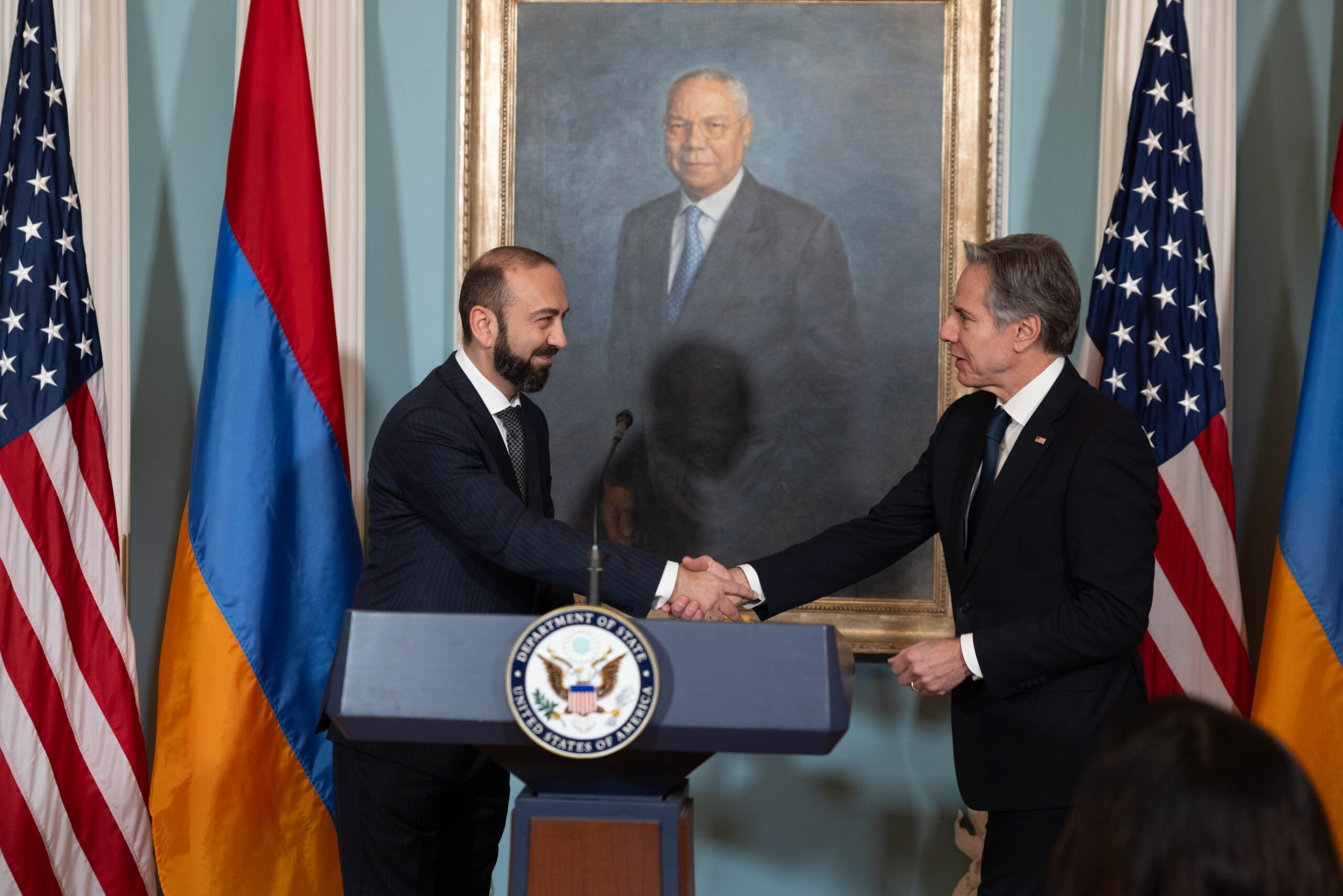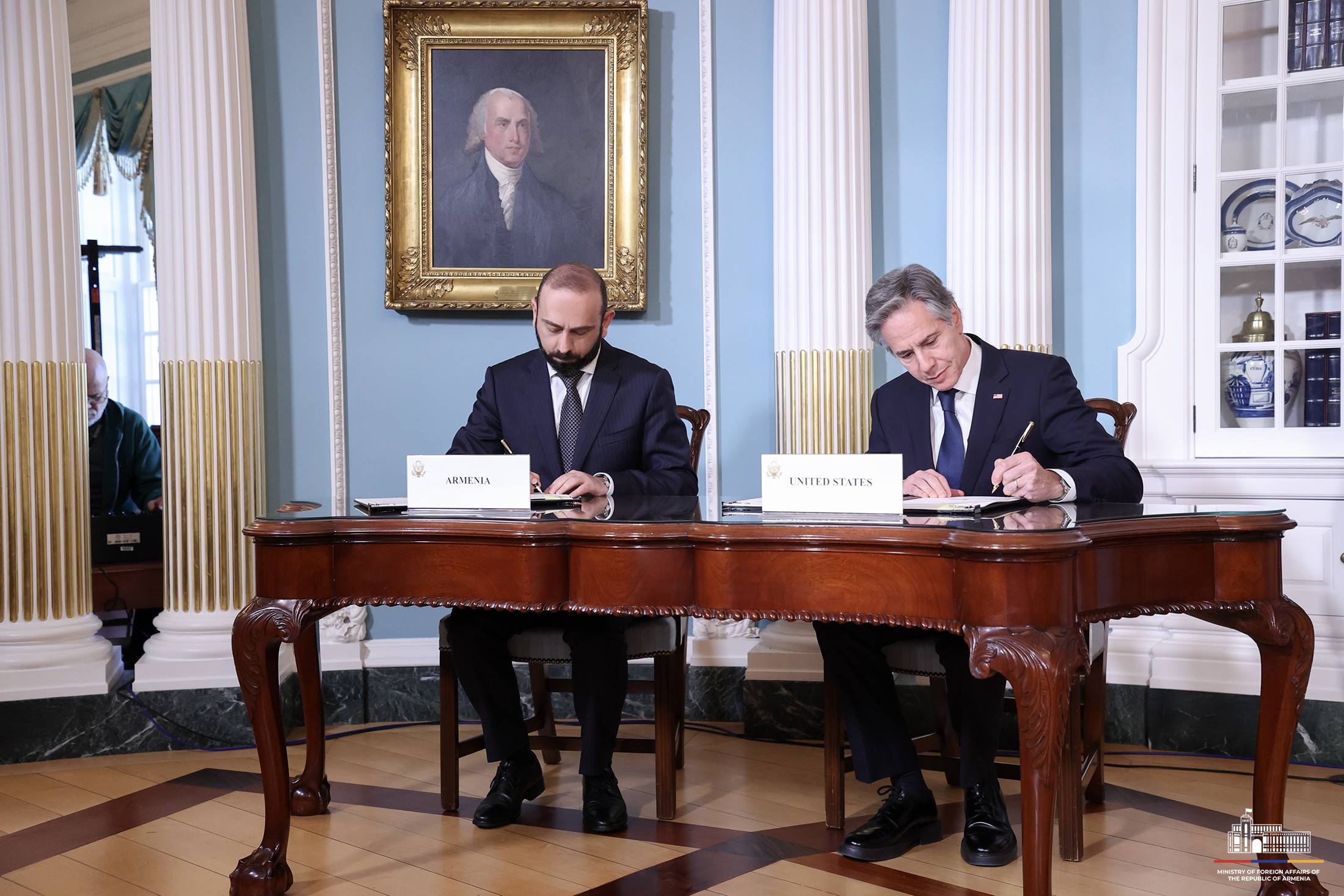
YEREVAN—In a significant shift for Armenia’s foreign policy, Armenia and the United States signed a Strategic Partnership Charter on January 14, 2025, in Washington, D.C. The agreement was signed by Armenian Foreign Minister Ararat Mirzoyan and U.S. Secretary of State Antony Blinken, setting the stage for enhanced bilateral cooperation across multiple sectors.
The Charter establishes a comprehensive framework for cooperation between the two nations, focusing on areas including defense and security, economic development, democratic reforms, energy, technology and people-to-people relations. This agreement represents a strategic pivot, with Armenia looking to deepen its ties with the United States while balancing its relationships with other regional powers.
At the signing ceremony, Foreign Minister Mirzoyan emphasized that the Charter “provides a robust framework and injects greater ambition into our cooperation.” The partnership seeks to expand economic and energy ties, deepen defense and security collaboration, reinforce democratic institutions, promote justice and the rule of law, and foster innovation on high technologies.
The agreement also creates a Strategic Partnership Commission. Secretary Blinken noted that both countries have already made significant progress in areas like border security, and future efforts would build on this momentum.
Secretary Blinken also announced that, in the coming weeks, the United States will send a Customs and Border Patrol team to Armenia to work on “border security capacity building, strengthening security cooperation [and] enhancing Armenia’s peacekeeping capabilities through exercises like Eagle Partner.” Eagle Partner is a U.S.-Armenia military peacekeeping drill.
In terms of security, both nations reiterated their commitment to the principle of mutual support for each other’s sovereignty and territorial integrity. The partnership is set to enhance Armenia’s defense capabilities through military training exercises, nuclear energy cooperation and joint commitment to nuclear nonproliferation.
Armenian Prime Minister Nikol Pashinyan has welcomed the agreement, noting that it reflects Armenia’s commitment to a “balanced and balancing foreign policy” which ensures the country’s “independence, sovereignty and statehood’s perpetuity.” PM Pashinyan highlighted that Armenia is deepening ties with the United States, while maintaining strong relationships with other regional and global powers, including Russia, Iran, Georgia and the European Union.
Regarding relations with Russia, Pashinyan said that Armenia’s partnership with Russia is “pragmatic,” focused on mutual cooperation and sovereignty. He also noted that Armenia’s relationships with the European Union and France are stronger than ever.
However, in a press conference on January 14, Russian Foreign Minister Sergey Lavrov spoke more critically about the state of Armenia-Russia relations. While remarking that the peoples of Armenia and Russia share a deep historical friendship, he said that relations have become unclear, reflecting the complexity of Armenia’s foreign policy choices in the present geopolitical climate.
“The signing of a strategic partnership with the U.S. is, of course, Armenia’s decision, and Russia does not impose restrictions on who Armenia can work with,” Lavrov said. “What matters most is not the label of the agreement but its substantive outcomes — what Armenia stands to gain from such a partnership.”
Lavrov cited remarks made by Russian Deputy Prime Minister Alexei Overchuk, who warned that Armenia’s simultaneous pursuit of membership in the European Union and the Eurasian Economic Union (EAEU) is incompatible. According to Overchuk, the EU and EAEU represent two distinct trade zones, making it “simply impossible” for Armenia to be a member of both.
“This is undeniably a sovereign decision of the Armenian leadership to pursue integration with any international organization,” Lavrov stated. “However, it is also the responsibility of Armenia’s leadership to weigh the pros and cons of such moves, especially in terms of their economic and political implications.”
Last week, the Armenian government backed a draft law in parliament on the “start of a process of Armenia’s accession to the European Union.”
Lavrov further addressed Armenia’s participation in the Collective Security Treaty Organization (CSTO), which has been a key element of its security policy. According to Lavrov, Armenia has effectively suspended its active participation in CSTO meetings and events. The Russian minister clarified that Armenia has not blocked CSTO decisions and the organization’s activities continue as usual.
“Armenia has paused its participation in CSTO events, but to be fair, they have made it clear that they are not obstructing the decisions of the organization,” Lavrov said. “Thus, the CSTO’s work continues, even though Armenia’s involvement is currently limited.”
Lavrov also confirmed that FM Mirzoyan has been invited to Russia and he has accepted the invitation. The visit is expected to take place in the near future, reflecting continued diplomatic engagement between the two countries, despite their recent differences.

Some critics of the U.S.-Armenia Strategic Partnership Charter argue that its implications for Armenia’s relations with Russia and Azerbaijan could lead to further tensions in the region. They suggest that the partnership could provoke a swift response from Azerbaijan, especially in light of ongoing negotiations over the Artsakh conflict and the Armenia-Azerbaijan border delimitation process.
Political scientist Suren Sargsyan has argued that while the agreement represents a strengthening of ties, it should not be confused with a full-fledged military alliance. It does not resemble the defense agreements between the U.S. and its allies Israel and the United Kingdom, where mutual security guarantees and military cooperation are central, Sargsyan wrote on Facebook.
One critical distinction is that the United States has made it clear that it will not provide Armenia with security guarantees or military aid, Sargsyan argued. This suggests that while the partnership will likely focus on economic collaboration, trade and diplomatic support, it will not extend to mutual defense obligations or the establishment of American military bases on Armenian soil.
The agreement comes at a time of rising geopolitical tensions in the region, particularly regarding Russia and Iran. Sargsyan argued that the timing of the agreement sends a strategic message to Russia and Iran, as both countries prepare to sign a comprehensive strategic partnership agreement of their own in Moscow on January 17.
This, according to Sargsyan, places Armenia in a delicate position. While it moves closer to the West, it risks alienating its traditional allies in Moscow and Tehran, who may view the partnership as a counterbalance to their influence in the region.
For Armenia’s leadership, the new partnership is seen as an avenue to diversify the country’s foreign policy and reduce dependency on Russia. However, Hrant Malik Shahnazaryan, Chairman of the Voskanapat Center for Strategic Research, suggested that this shift comes with significant risks. He argued that by aligning with the U.S., Armenia could provoke geopolitical confrontations with Azerbaijan and Turkey.
In a social media post, Shahnazaryan said that while Armenia may seek to strengthen its ties with Western powers, the long-term costs of alienating Russia and Iran are uncertain. Armenia’s position between Azerbaijan, Turkey and the broader Iranian-Russian alliance creates a precarious balance, one that may become increasingly difficult to maintain. Shahnazaryan warned that by moving closer to Western powers, Armenia risks becoming a battleground for competing geopolitical interests.
In particular, Armenia’s Syunik province could become a flashpoint. Shahnazaryan suggested that Azerbaijan, already emboldened by its success in Artsakh, might see this new partnership as justification for further military action. Should such an escalation occur, Armenia could find itself drawn into a larger conflict, with Russia and Iran on one side and the U.S. and Azerbaijan on the other.


Delusional and meaningless.
99.99% of Americans can’t find Armenia on a map.
The Americans are not going to bomb Turkey when the Turks invade.
The only people who will support this are the ones who failed their geography exams at school.